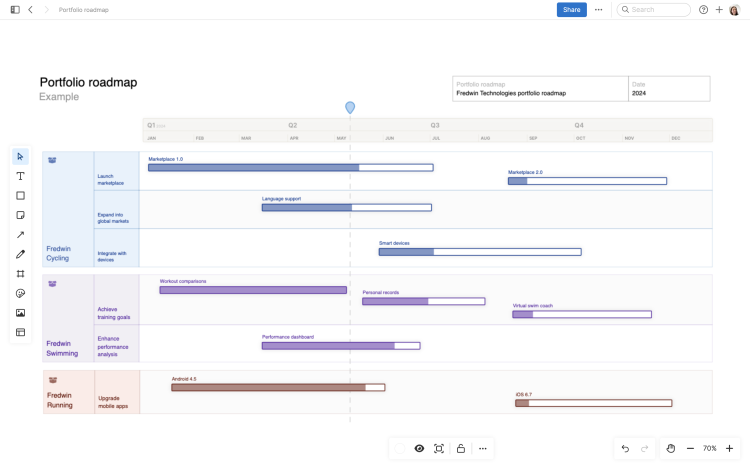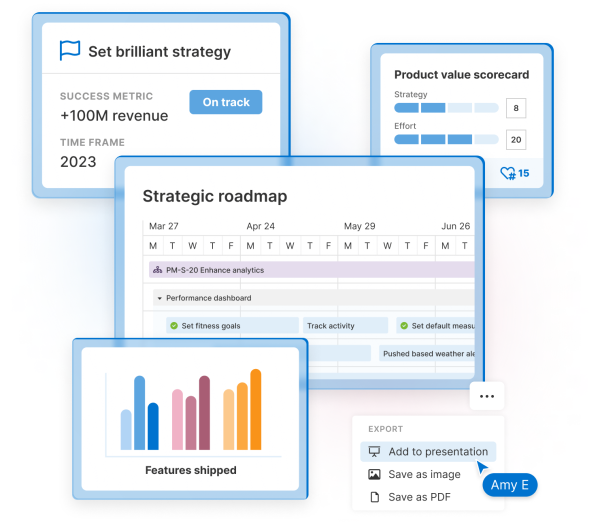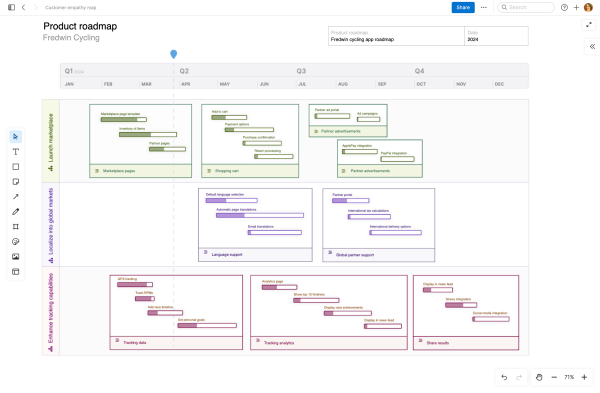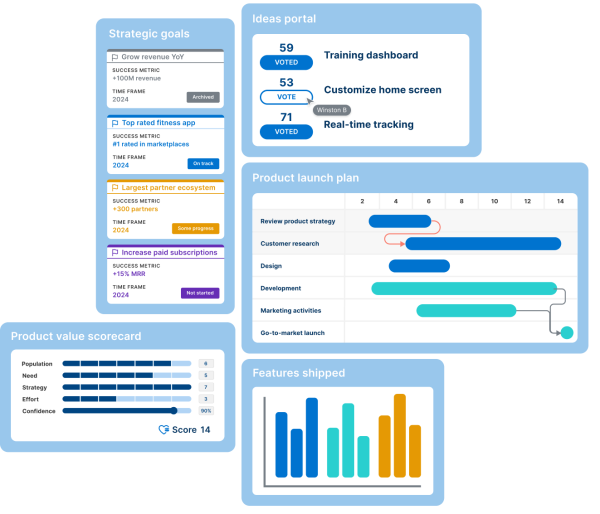13 essential whiteboard templates for program and portfolio management
Last updated: April 2024
Projects belong to programs as programs belong to portfolios. It sounds like a word problem from a school assignment, but each plays a crucial part in aligning complex cross-functional projects with broader company goals. This is especially true at large enterprise companies with a wide-ranging suite of products.
Delivering value across a company's products or services requires a connected strategic focus and persistent vision. Teams have to work together to ensure that the initiatives set for each program align with the initiatives set for each product or product line — ultimately mapping to the high-level company strategy. This work is complex. And it is why many large enterprises bring on program managers and portfolio product managers.
Build a roadmap for product success in Aha! Roadmaps. Start a free trial.
The ability to problem-solve, collaborate, and build a strategic plan (which culminates in a roadmap) are all key pieces of program and product portfolio management. Use whiteboard templates to streamline these three activities and more. Whiteboard templates help program and portfolio managers gain efficiencies across cross-functional teams — fast-tracking coordination with an open-ended, interactive space for getting work done.
What kind of templates are we talking about? Let's dig in and discover 13 whiteboard templates available in Aha! software that can support program and portfolio management right now.
Use the following links to jump ahead to any section:
Program management vs. portfolio management
Up to this point, it might sound like program and portfolio managers do the same thing. Although similarities exist, their specific roles and responsibilities are distinct.
Program management oversees a program or set of related projects to completion. A program manager is responsible for the success of all related projects that support a strategic initiative.
Portfolio product management is the process of managing a company’s product portfolio or the complete collection of products and services a company offers. Portfolio product managers oversee new product development, lifecycle management for existing products, and integration of any products brought on through mergers and acquisitions.
Definitions aside, let's explore a few more details using the grid below:
Responsibility | Strategic focus | Everyday work | Example | |
Program manager | Coordinate all cross-functional efforts across a collection of projects (that constitute a program) to achieve specific business objectives. | Create program-level roadmaps for a group of projects and ensure the all-up program supports portfolio/company objectives. | Define success metrics, set high-level budgets, track progress, and create efficiencies across the program. | Implementing a companywide IT transformation program that includes multiple interconnected projects (such as upgrading hardware, implementing new software systems, and training employees). |
Portfolio manager | Ensure the success of a group of programs across products, connecting these contributions to broader top-line business goals.
| Set strategy for a portfolio of programs to create alignment with overall organizational strategy. This is often visualized using a product portfolio roadmap. | Analyze, measure, and optimize how existing products contribute to broader business goals. This includes balancing program activity within the portfolio and determining resources across all programs. | Segmenting products based on markets and needs, allocating resources based on growth potential, divesting underperforming products, and investing in new opportunities. |
Keep in mind that both roles can vary greatly by organization and team structure. Some program managers focus more on high-level planning, whereas others might be more hands-on with day-to-day management. And although portfolio managers are generally very strategic, some might be more involved in financial management and investment decisions.
Related:
Whiteboard templates for program and portfolio management
For program and portfolio managers, time is split across myriad tasks: strategy refinement, ideation and problem-solving, roadmapping, and, of course, keeping stakeholders close to the work. Creating a standard process that streamlines these tasks boosts efficiency, and customizable templates can help. Using templates helps develop a repeatable and familiar system around the work — improving productivity and visibility for team members.
At Aha! we maintain a library of more than 100 whiteboard and note templates to help folks create and showcase their work. Built by product experts, each template comes with best practices (including guided instructions and advice) — all meant to help teams make collaboration easier. Use templates to set up a consistent framework for cross-functional teams and executive leaders, and empower everyone to contribute.
With that in mind, it is important to choose the right template to manage the different stages of program and portfolio management. Here are a few suggestions for getting started:
Strategize
SWOT analysis template: This template supports strategic analysis. Use it to identify strengths, weaknesses, opportunities, and threats within a program or portfolio — aiding decision-making and risk management.
OKRs template: Help define and track objectives and key results for the team's work, aligning activities with strategic goals and developing a framework to measure performance.
Strategy mountain template: Visualize strategic priorities and their interdependencies along with essential steps needed for success — and any challenges.
Stakeholder map template: Regular progress updates to key stakeholders are a common component of program and portfolio management. Identify who to connect with and how often using a stakeholder map.
Explore
Opportunity canvas template: Validate the potential for innovation or improvement within the program or portfolio. Use this template to streamline decisions surrounding whether or not to pursue specific opportunities.
Workflow diagram template: Fully understand and optimize a sequence of activities within a program or portfolio, identifying what works and what could be improved.
Problem framing template: Use this template to clearly define the scope and objectives of any problem. Identify who is impacted, details surrounding the source, and the related work to uncover the root cause.
Plan, roadmap, and showcase
Epics roadmap template: Group related features, or themes of work, based on completion date by release. Use this template to guide early-stage planning discussions, capturing product goals that each release supports.
Presentation slides template: Communicate program or portfolio strategies, plans, and updates to stakeholders — facilitating engagement and alignment.
Product portfolio template: Bring quick visibility to the key areas of strategic investment across projects or programs. This single dynamic view helps executives understand how projects or programs relate to one another and the overall goals and initiatives.

Consolidate the strategic direction of multiple products, programs, or projects using a portfolio roadmap template in Aha! software.
Document
Decision log template: Track decisions made throughout the program or portfolio lifecycle, providing transparency into the work and accountability across the team.
Process improvement template: Apply best practices to any team process, procedure, or workflow.
Knowledge base article template: Document and disseminate critical information to teams. Use this template to standardize knowledge capture, ensuring consistency across all internal support content.
New program and portfolio initiatives can come to life with whiteboard templates. But here is the best part: When used alongside integrated product-building software such as Aha! Roadmaps, it is easy to convert any early-stage whiteboard element into an idea, feature, epic, initiative, or goal on the actual roadmap. See what we mean by watching the tutorial below:
Editor's note: Although the video below still shows core functionality within Aha! software, some of the interface might be out of date. View our knowledge base for the most updated insights into Aha! software.
FAQs about program and portfolio management
What customization options are available for the templates listed?
Each template (in our library of more than 100) includes relevant best practices and a pre-filled example. But you can modify any note or whiteboard template to fit your specific needs. Include rich text formatting and change labels, colors, and shapes. Add media such as screenshots and include dynamic diagrams. With the Aha! Whiteboards Advanced plan, you can also create your own custom templates and share them across teams.
How do templates facilitate better communication and collaboration among cross-functional teams?
Using consistent templates across teams and departments helps ensure all information is communicated in a clear and accessible way. This promotes alignment and participation cross-functionally, as everyone becomes accustomed to the same workflow and process. With Aha! Whiteboards, you can invite unlimited guests to your whiteboards and adjust permissions depending on the level of feedback needed. View, edit, comment, react with emojis, and even vote on specific aspects of your whiteboard to secure the valuable input needed to move ahead.
With regard to the roadmap whiteboard templates, how do I know when it is time to shift to more robust roadmapping software?
Whiteboard templates such as the epics roadmap and product portfolio roadmap (both mentioned in this guide) are ideal for sketching out early-stage plans within program and portfolio management. Use them to quickly visualize your thoughts and collaborate on plans with the team.
As concepts begin to solidify and it is time to get more detailed, you can take any element within your whiteboard template and convert it into an initiative, idea, epic, or feature within more robust software such as Aha! Roadmaps. And it goes both ways. That means you can pull any existing ideas, epics, and feature records into your whiteboard, giving you the flexibility to explore different approaches before finalizing the path forward.


